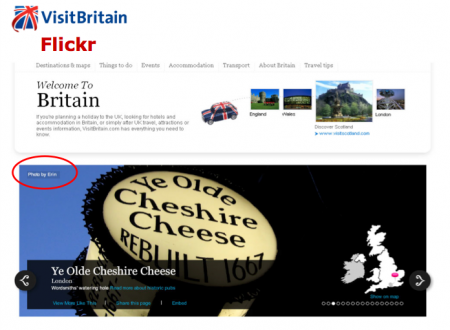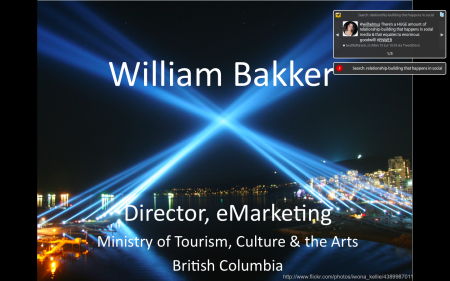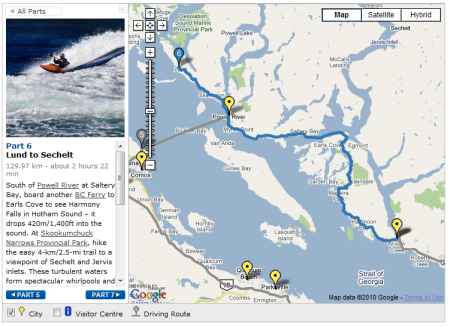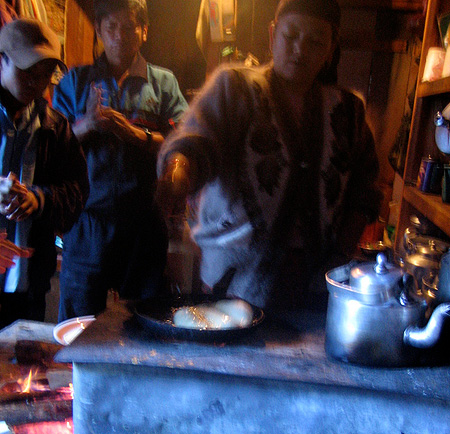July 2010
The Archives
-
Internet, Marketing, Travel & Tourism
Take-aways from VisitBritain’s social media presentation

Somebody emailed me this webcast where Justin Reid from VisitBritain shares their social media strategy, examples, results and learning. Very insightful. Here are my key take-aways.
People don’t make a travel decision on a national tourism board website
Justin said: “Our research told us that the majority of long haul travelers visit a national tourist board after they’ve already made the decision to visit”
VisitBritain’s rightly concluded that in order to target people in the decision making process, they need to engage in other places like third party websites. A content partnership with Yahoo is working very well for them for example.
The future of CRM/eMail Marketing is under threat
Justin said: “Where previously you might have focused a lot of CRM activity we learned that the inbox is no longer a happy place. People want to clear it out as fast as possible. So we now want to focus on finding places where people are in the mindset of making decisions about travel [social media].”
I wondered about the same thing about a year ago in this blog post. As people become overwhelmed with email, they pay less attention to marketing messages, even when they opt-in. This kind of change won’t happen overnight but social media is an environment where people are easier to engage, two-way dialogue is possible and content is easy to share.
Social Media’s network effect has incredible reach
Justin: “10,000 followers is amazing. But we followed the traffic of some of our tweets and each of our tweets reaches a potential audience of about 325,000 people”
Through re-tweets on Twitter, and by tagging and sharing on Facebook, a message can travel far and wide in a very short period of time. And the content itself is much more credible because it’s endorsed by a friend who shared it.
Tourism Australia’s fanpage with over 600,000 fans is a good example. Every message they posts could be read by that many people. And for every person that comments on the post, the post gets published to their friend network, extending reach with the potential to organically grow their fanbase.
And as a side-effect, “Facebook is now the third largest referrer to VisitBritain after Google and Yahoo, and we’re not even seeking to push people to the website.”
Content is far more important than a website
Justin: “Our website is not the most important marketing tool for us, our content is. We’re just as happy if somebody reads our content on Yahoo as on our website.”
VisitBritain is agnostic about where content is being consumed and as a result, more of VisitBritains content is being consumed on third party websites. A partnership with Yahoo produces an exponential amount of views, for free. More videos are viewed than some market websites receive visitors.
Producing or gathering the right content, and pushing it out into place where you add value for the publisher and the consumer, preferably with easy sharing opportunities is much more effective than trying to generate website visitation through advertising alone.
User Generated Content is an easy and cost-effective way to publish content
Justin: “95% of VisitBritain’s photography comes from user generated content” and “when somebody’s photo appears on a national tourism boards site, you can bet on it they will send a link to all their friends to check it out.”
VisitBritain set-up a Flickr group called Love UK and is using it as one of the sources for its photos on VisitBritain.com. And because most people are happy to see their photography used, they will tell everybody about it.. on social media.
Brilliant. This is something I’ve advocated for years but I could never get it going. Well done VisitBritain.
Thanks for sharing Justin!
-
Internet, social media, Travel & Tourism
First look at Facebook Questions – Lots of potential
07.28.10 | Permalink | 8 Comments
Today Facebook launched Facebook Questions, “a beta product that lets you pose questions like these to the Facebook community. With this new feature, you can get a broader set of answers and learn valuable information from people knowledgeable on a range of topics.”
The new feature is slowly being rolled out. It’s extremely buggy for me at the moment. Searching for questions about specific topics or keywords doesn’t work at all for example.
But the concept is becoming clear.
Facebook is making clever use of the social graph (friend networks) and user profiles. Questions asked by my friends and topics I’ve have listed as interests where listed first for me. You can also send a question to a friend. Inside Facebook as more details about the product and how the social graph is used.

What’s great for fanpage owners is that you ask and answer questions as the fanpage.
For DMO’s and travel operators, monitoring questions and answering them can be a powerful way to built relationships with potential customers. Besides it’s incredible userbase, its use of the social graph and ability for fanpages to participate makes it a great tool for engagement.
-
leadership, Management
Must see presentations #5: Itay Talgam: Lead like the great conductors
Don’t tell people how to do things, tell them what to do and let them surprise you with their results.
— George S. PattonI believe that great leaders are passionate people who set a vision and inspire teams and individuals who’ve been given the space to make the vision a reality.
Itay Talgam delivered a great presentation at TED where he uses different styles of symphony conductors to deliver a powerful message about how to lead talented individuals. Very insightful.
-
Internet, Marketing, personal, Travel & Tourism
Presenting with a live twitter feed at PNWER

Today I presented our social media strategy for the 2010 Olympic and Paralympic Games at the PNWER conference in Calgary. One of the things that goes through my mind while I’m presenting these days is “what are people in the audience tweeting about this presentation RIGHT NOW?” Today was different. I could see exactly what was going on.
At the start of my presentation I asked @seattlemaven (who runs Seattle’s Twitter account and was invited to speak but couldn’t be there in person) and the Twitterverse in general a few questions about social media via Twitter. I set-up Tweetdeck notifications and throughout the presentation, answers and comments popped-up on the screen.
The result was organized chaos, but I think it told an interesting story about the power and immediacy of social media. Either way, I had a lot of fun and great feedback from the audience.
Here are the questions I asked and the answers that came by during my presentation.
@seattlemaven When did you start, how many interactions do you have a day on average, and how much time does it take you?
- @wilhelmus Began Soc Med in June 2009. Currently 120K FB fans & nearly 6K Twitter followers. Brings truckloads of positive sentiment! #PNWER
- @wilhelmus Generally I answer between 10-30 ?s in a day. Time allowing, I also ‘jump into’ convos already happening about our city. #PNWER
- @wilhelmus Public tweets approx 10x/day – generates a lot of responses & builds our following AND the essence of Seattle/NW #PNWER
- @wilhelmus 1 hr/day, I’d estimate (but the fun-factor’s HUGE!) :o) #PNWER
@seattlemaven How are you different from a phone or in-person interaction with a consumer?
- seattlemaven: @wilhelmus Twitter allows me to speak to broader audience. 1 public tweet may answer question of 200 followers – that’s powerful! #PNWER
- seattlemaven: @wilhelmus Following me early (B4 arrival) they gain greater sense of area & more comfortable/willing to explore once they arrive. #PNWER
@seattlemaven What’s the best new hot bar in Seattle for a bachelorette party? (audience question)
- seattlemaven:@wilhelmus Pnk Ultralounge opens in a month – we can’t wait! Swanky & hot!!
- seattlemaven:@wilhelmus Amber in Belltown’s hip & fun – great drink specials & a private room that’d knock their socks off!
Tweeps, join me live at a conference. 1) Why should businesses care about social media? #PNWER
- mikalat: @wilhelmus Best advice for social media: figure out where your customers are/what they’re using. Start there, don’t worry about the rest
- seattlemaven: @wilhelmus #1 reason to start SM: People are talking (about you and others) you can either jump into the conversation or not. Do it! #PNWER
- mikalat: @wilhelmus Also – LURK! Read, follow and find out what your competitors are doing and take notes. Learn first, dive in second.
- erikrolfsen: @wilhelmus Don’t be a stranger. Fill out that profile information and do it in a way that will interest people.
2) What’s your #1 piece of advice when starting in social media? #PNWER
- nigel220: @wilhelmus we could learn a lot by listening to our youngest employees when it comes to social media!!
- seattlemaven: @wilhelmus über-important to be authentic — your audience knows canned vs. real! Real = experiences, voice, personality #PNWER
-
Internet, Marketing, tourism bc, Travel & Tourism
New on HelloBC.com: interactive driving routes

A few weeks ago we launched new functionality on HelloBC.com and it’s probably the best work we’ve done to date.
BC is a large and diverse province and in order to fully experience it you need some wheels. To make planning a driving vacation easier, we added new functionality to enhance our driving routes content and make it easier to plan a trip.
This new section takes full advantage of Google Maps, includes detailed maps, driving routes and information about cities and towns you pass through. The location of our Visitor Centres are also present. Long routes, like the Heritage Discovery Circle Tour (3,498 km) are divided into manageable parts. You’ll read about highlights, what you can expect and see photos of the scenery you’ll find along the way.
Go check out our new driving routes. We’re already working on Phase 2 to make the experience even better.
Thank you Holly, Patrick, Tammy, Sarah, Karen, Mikala, Rob, Ana, Galina and everybody else who made this happen.
-
leadership, Management, Marketing, social media, Travel & Tourism
To be Authentic

The best meal I ever had wasn’t at a fancy restaurant, made by a celebrity chef, with an award winning wine. It was at a small B&B in Chame, Nepal. Because it was freezing cold we huddled around the kitchen fire where dinner was being made.
The whole family helped out. Kids were preparing veggies, the husband was making the dough for bread and mom was in charge of everything and everybody. Friends and family came and went.
That Dal Bhat was the best meal I’ve ever had. Because it was an authentic experience.
The word authentic keeps popping up lately. Tourists increasingly want authentic experiences. In social media, you need to be authentic to be successful. To be authentic is to be real and genuine.
Simon Sinek, who writes fantastic stuff about leadership by the way, talks about imperfection and authenticity in this blog post.
Perfection comes out of molds or off assembly lines. Things made by nature or by hand are imperfect. It is their flaws that make these objects unlike any other of their kind. It is their imperfections that make these things unique and beautiful.That’s why so much marketing is junk. People try to make it too perfect and as a result, the message isn’t authentic anymore. It’s like most marketing comes from the same assembly line. Killed by process, approvals and egos.
Imperfection is not always a bad thing, when it creates authenticity. Keep this in mind for your business. Don’t mold it like everybody else’s (but don’t use your bathroom as a place for imperfection). Give staff some room to be themselves so they don’t sound like robots and give them the ability to think on their feet and give customers personalized attention.
And in social media, authenticity is a must. Don’t always try to craft the perfect message. Be yourself and try to have meaningful relationships with your network. Just don’t be stupid. And when you make a mistake, apologize.
I’ll finish by quoting Simon one more time.
Great leaders don’t try to be perfect, they try to be themselves. And that’s what makes them great. -
Internet, Marketing, social media, Travel & Tourism
Tripadvisor offers a glimpse into the future
07.12.10 | Permalink | 4 Comments
Science fiction writer William Gibson once said “The future is already here – it’s just not evenly distributed.” You can see what some of the future will look like with Tripadvisor’s ‘Trip Friends’.
About 7 years ago we ran some focus groups in San Francisco to learn more about the trip planning process. I remember that involving real people was a very important part of the process. I concluded that people prefer to talk to people in this order:
- People they know and live in the destination they want to visit
- People they know and have been in the destination they want to visit
- People they don’t know and live in the destination they want to visit
- People they don’t know and have been in the destination they want to visit
Tripadvisor is serving up information from group #4 very well; with it’s reviews and message boards. With their ‘destination experts’ on their message boards they also started using group #3.
Now Tripadvisor has also figured out a way to include groups #1 and #2, the most credible sources of information to a trip planner.
A few years ago, Tripadvisor bought the Facebook app “Where I’ve been” for a reported $3M. At the time it was a gimmicky app where you could plot pins on a map for places you’ve visited anywhere in the world. The app was successful because it taps into one key motivator for travel; making my friends and family jealous of the places I’ve been. Tripadvisor also bought it’s 2.3M users. Tripadvisor rebranded it “Cities I’ve visited” and incorporated it into it’s website and has done a decent job of improving it.
Users can add cities they’ve visited, where they want to go, their favourite cities and what cities they can give advise for. The app has an active userbase of 4.8M when I checked today. And I’m sure there are many more users on the Tripadvisor website. As a result, Tripadvisor has an incredible amount of intelligence about their member’s travel history and desires.
Tripadvisor has mashed up with own intelligence with Facebook’s through Facebook Connect and the Open Graph. When you log into Tripadvisor with Facebook connect, and you visit a city page, you’ll now see a list of your friends who:
- live in a particular city
- have a particular city listed as a favourite
- have been to a particular city
- are going to a particular city
Tripadvisor allows you to use Facebooks social networking tools to send a message to one or more of your friends to ask for advise about your upcoming trip based on this information.
Even though it’s a small step, it’s very useful and also a significant indicator of future possibilities for combining your own consumer data (like Tripadvisors data about where people have been) with Facebook’s social graph and social networking power.
“The future is already here – it’s just not evenly distributed.”
Note: I intended to write this post much sooner. But the future is also unevenly distributed by individual and my attempts to login to Tripadvisor with Facebook connect has resulted in error messages for a month now. I’ve reported the error at least a dozen times but I had to resort to using my wife’s Facebook credentials to have a look at this feature.
-
Internet, Management, Marketing, social media, Travel & Tourism
Sheraton Tripadvisor Cards

A few weeks ago I spoke about our online marketing activities during the 2010 Olympics in Seattle. I stayed in the Sheraton; great hotel. They left a really nice note in my room, including this card to encourage me to share my experience on Tripadvisor. Simple and effective.

